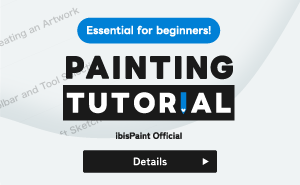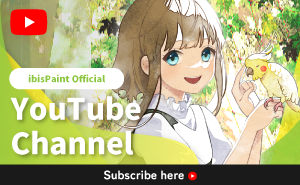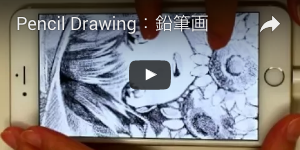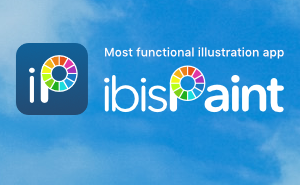Tutorials
46. Vector Layer
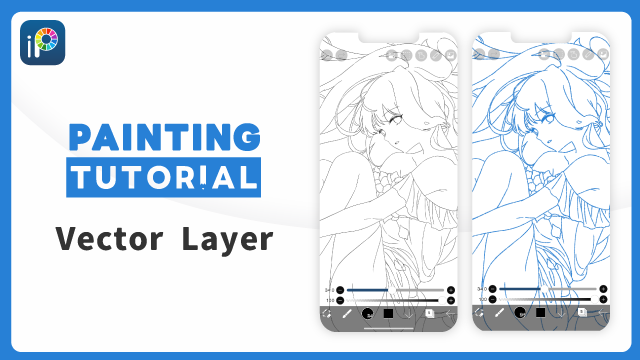
What is a Vector Layer
A vector layer is a special layer where the data does not degrade even with repeated scaling.
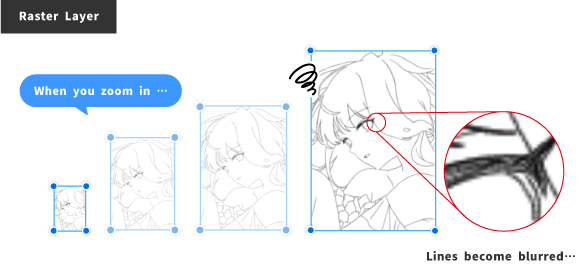
Lines drawn on a raster (normal) layer degrade with each scaling,

Meanwhile, lines drawn on a vector layer do not degrade even with repeated scaling.
The difference between Raster Layer and Vector Layer
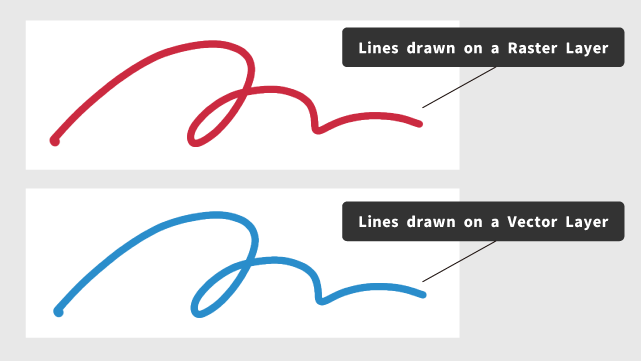
There is no visual difference between lines drawn on vector layers and raster layers. The difference is in the way each layer records the drawn lines.
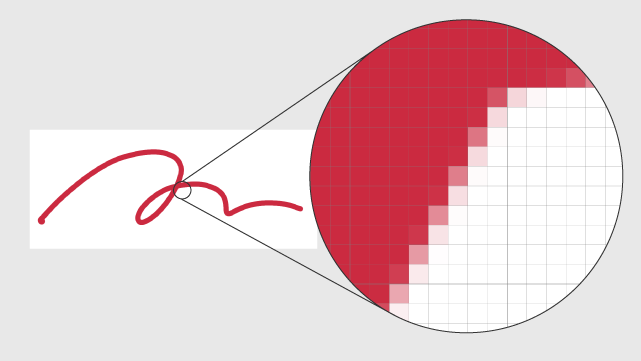
Raster layers are composed of small squares (pixels).
One advantage of raster layers is that there are no limitations on functionality. You can easily perform all the necessary steps for drawing a picture, such as line drawing, coloring, and processing. However, the biggest weakness is that when you enlarge, reduce, or transform, the lines degrade.
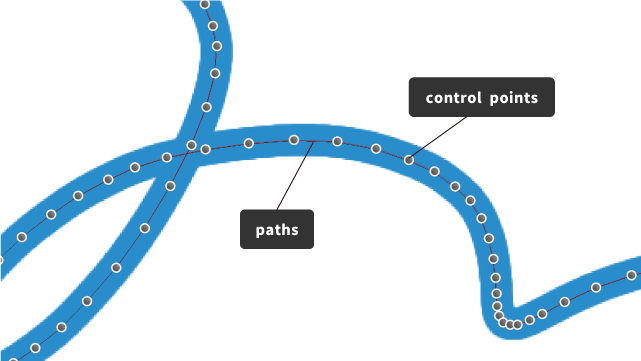
On the other hand, the vector layer is drawn with coordinates of points (control points) and lines connecting the points (paths).
The information of the lines is recorded by these control points and paths, allowing the lines to remain clean even when zooming in or out.
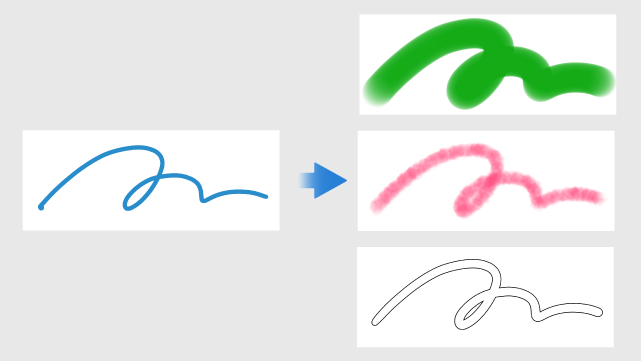
Additionally, lines drawn on vector layers can be modified later to change the type of pen, thickness, and color of the line.
This is also considered a benefit of using vector layers.
However, the drawback is that some functions such as fill tool, fingertip tool, and blur tool are not available. Taking the above into consideration, vector layers are proficient in drawing lines, while raster layers excel in other general tasks ( such as coloring and processing).
How to use vector layers
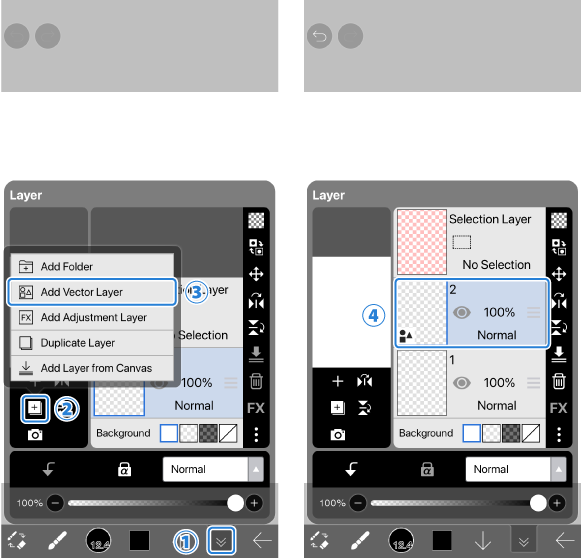
Open the ①[ Layer Window ].
Select ②[ Add Special Layer ] and then choose ③[ Add Vector Layer ].
Select the newly added ④[ New Vector Layer ] on the working layer.
All lines drawn on the vector layer will be displayed as vector lines.
In addition to the above methods, a vector layer can be added by using the Vector Dip Pen and Vector Felt Tip Pen .

Open the⑤[ Brush Window ].br>
Select ⑥[ Vector Dip Pen ] or ⑦[ Vector Felt Tip Pen ] from the brush list and draw a line on the canvas.
Open ⑧[ Layer Window ] and you will see that ⑨[ New Vector Layer ] has been added.
The limitations of using vector layers
As mentioned earlier, there are several functions that cannot be used in vector layers. If you want to use the following functions, you need to rasterize the vector layer:
- Blur / Smudge tool
- Alpha lock
- Perspective transformation / Mesh transformation
- Filters
You can rasterize a vector layer in the following ways.
* Be careful because once you rasterize, you cannot revert it back to a vector layer.
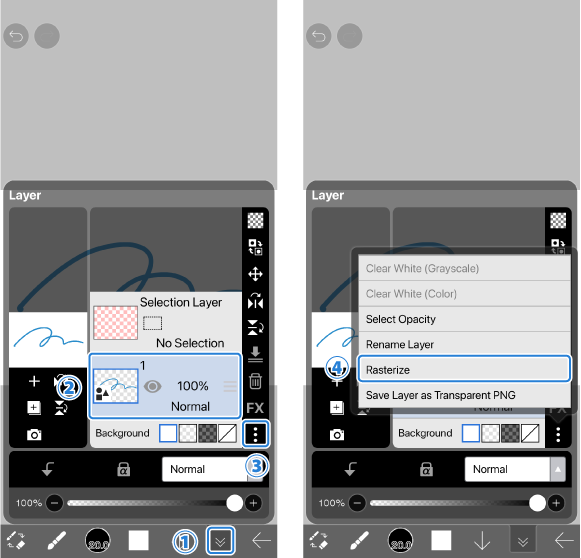
Open the ①[ Layer Window ]
Select the ②[ layer you want to rasterize ] and tap the ③[ 3-dots button ].
Choose ④[ Rasterize ] from the command menu.

Confirm the rasterize dialog box by selecting the ⑤[ Yes ] option.
The icon of the vector layer will disappear, indicating that it has been converted to a raster layer.
Adjusting the line

Select ②[ Vector ] from the ①[ Tool Selection Window ].
Choose the line you want to edit, then select ④[ Edit Vertices ] from the ③[ 3-point Button ].

Drag the ⑤[ Control Points ] to shape the line as desired.
Once adjustments are done, tap on ⑥[ ✔︎ ].
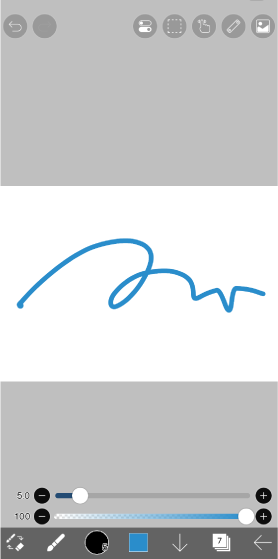
You have adjusted the line after drawing it.
How to change the style of a line
Lines drawn on a vector layer can be modified later to change the type of pen, thickness, and color of the line.
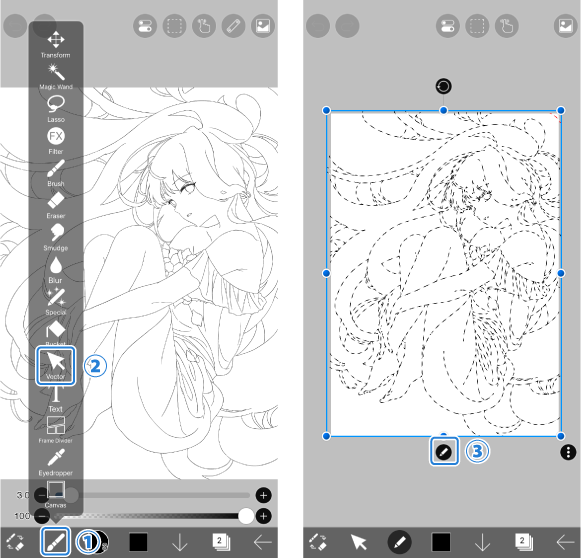
Select ②[ Vector ] from the ①[ Tool Selection Window ].
Choose the line you want to edit, then tap on the ③[ Edit Button ].
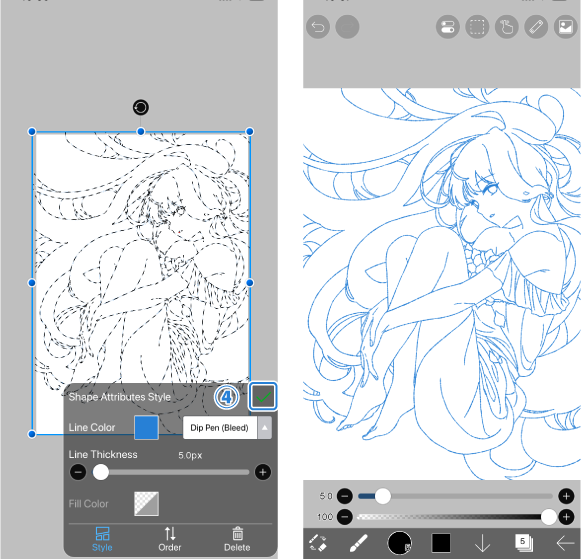
Adjust the color, pen type, and line thickness to your liking.
Once you're done adjusting, apply it by tapping on ④[ ✔︎ ] to finish.
You can easily change the atmosphere of the illustration without redrawing the lines.
Eraser on a Vector Layer
When using the eraser on a Vector Layer, strokes get erased in a different way compared to erasing them on a Raster Layer. This article may provide a solution for those who have encountered a situation where lines unintentionally disappeared after joining Vector Layers. Hereinafter, the eraser used on a Vector Layer will be referred to as the "Eraser on a Vector Layer".

When you merge vector layers, unintended lines may disappear. Let's clarify this using the illustration in the diagram above. The top layer will be denoted as [A], the middle layer as [B], and the background layer as [C].
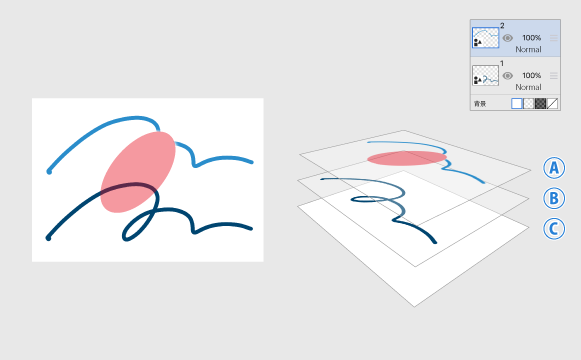
Some parts of the lines drawn in [A] are erased using an eraser. (The areas where the eraser was used are indicated in red.)
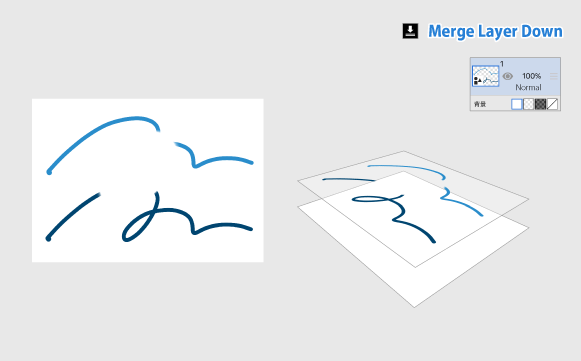
Next, merge layers [A] and [B]. As a result, some lines of [B] will also disappear. Many people may have experienced this when using vector layers. Some lines of [B] disappeared due to the mechanism of the Eraser on a Vector Layer.
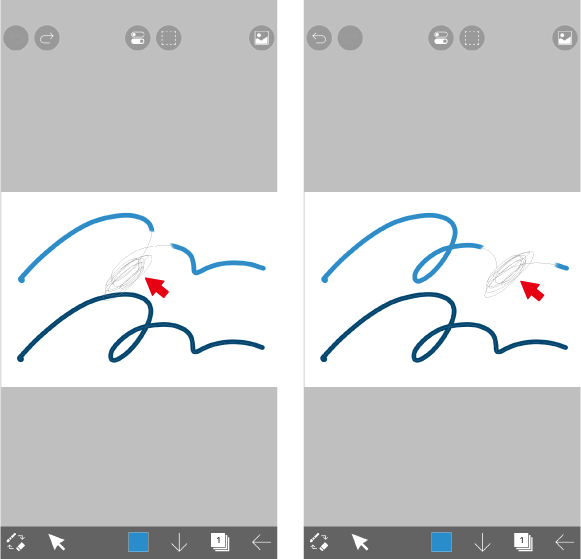
When checking with the vector tool, you can see that there are vector lines without color in the areas where the eraser was used. These transparent vector lines are what the Eraser on a Vector Layer really is. The Eraser on a Vector Layer can also be used to move and change styles, same as vector lines.
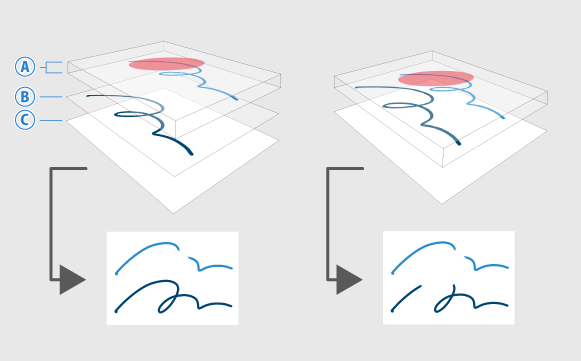
The Eraser on a Vector Layer does not actually erase the lines, but rather temporarily hides the lines underneath by overlapping them on the same vector layer. Therefore, it is easier to understand if you think of the lines as being hidden under transparent lines, rather than being erased.
You can bring back the accidentally hidden lines by following the steps below.
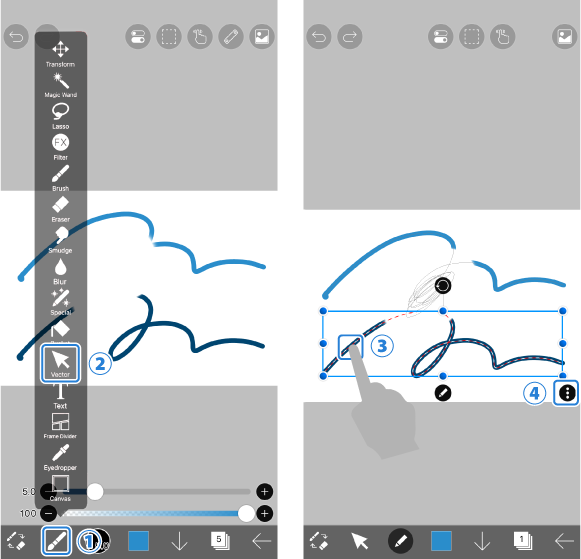
Select ①[ Vector ] from the ②[ Tool Selection Window ].
Choose ③[ the desired line that you want to display again ] and tap on the ④[ 3-dots button ].
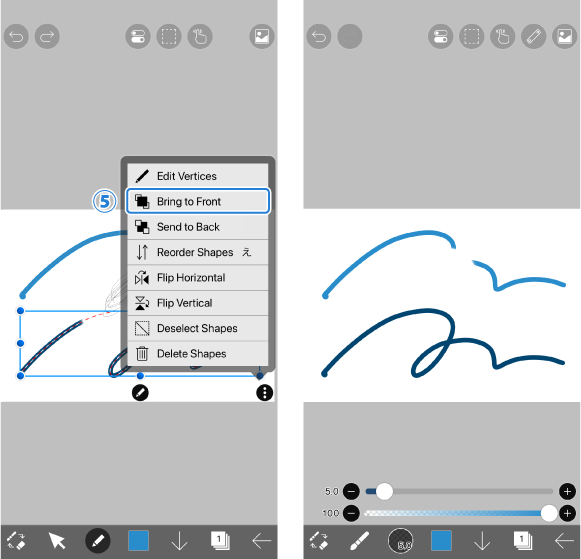
Select ⑤[ Bring to Front ] and move the desired line to the front.
You can now bring back the hidden line by displaying it again.
Chapter
-
 01.Introduction
01.Introduction -
 02.Start Creating an Artwork
02.Start Creating an Artwork -
 03.Toolbar and Tool Selection
03.Toolbar and Tool Selection -
 04.Do Your Draft Sketch by Hand
04.Do Your Draft Sketch by Hand -
 05.About Layers
05.About Layers -
 06.Let's Trace
06.Let's Trace -
 07.Undo and Eraser
07.Undo and Eraser -
 08.Fine Tuning Using the Lasso tool
08.Fine Tuning Using the Lasso tool -
 09.Check by Reflecting Horizontally
09.Check by Reflecting Horizontally -
 10.Select Colors in the Color window
10.Select Colors in the Color window -
 11.Use Color Fill for the Undercoat
11.Use Color Fill for the Undercoat -
 12.Turn Clipping On
12.Turn Clipping On -
 13.Making a Gradation (Shading)
13.Making a Gradation (Shading) -
 14.Select a color from the canvas or layer
14.Select a color from the canvas or layer -
 15.Create Highlights and Shadows
15.Create Highlights and Shadows -
 16.Paste a Texture
16.Paste a Texture -
 17.Let's Merge Layers
17.Let's Merge Layers -
 18.Sign Your Artwork
18.Sign Your Artwork -
 19.View Your Artwork
19.View Your Artwork -
 20.Post Your Artwork
20.Post Your Artwork -
 21.Share Your Artwork
21.Share Your Artwork -
 22.Open your ibisPaint data in Clip Studio Paint
22.Open your ibisPaint data in Clip Studio Paint -
 23.Prime Membership / Remove Ads Add-on (iOS,iPadOS,Android versions)
23.Prime Membership / Remove Ads Add-on (iOS,iPadOS,Android versions) -
 24.Prime Membership / Pro Add-on (Windows Version)
24.Prime Membership / Pro Add-on (Windows Version) -
 25.Synchronizing the artworks on your device with Cloud Storage
25.Synchronizing the artworks on your device with Cloud Storage -
 26.Save the past state of an Artwork as an IPV file
26.Save the past state of an Artwork as an IPV file -
 27.Rearrange artworks
27.Rearrange artworks -
 28.Make custom brush
28.Make custom brush -
 29.Installing and Exporting the Custom Brush
29.Installing and Exporting the Custom Brush -
 30.Release a Custom Brush to the Online Gallery
30.Release a Custom Brush to the Online Gallery -
 31.Brush Export and Import
31.Brush Export and Import -
 32.Search For Brushes
32.Search For Brushes -
 33.Display images to use as reference
33.Display images to use as reference -
 34.Add Color to the Analog Image using Multiply
34.Add Color to the Analog Image using Multiply -
 35.Stabilizer
35.Stabilizer -
 36.Layer: Clipping is convenient
36.Layer: Clipping is convenient -
 37.Layer: Changing the color with Alpha Lock
37.Layer: Changing the color with Alpha Lock -
 38.Layer: Let's try using Screen Tone
38.Layer: Let's try using Screen Tone -
 39.Layer: Selection Layer
39.Layer: Selection Layer -
 40.Layer: Save Layer as Transparent PNG command
40.Layer: Save Layer as Transparent PNG command -
 41.Layer: Naming your layers to manage them
41.Layer: Naming your layers to manage them -
 42.Layer: Rasterize
42.Layer: Rasterize -
 43.Layer: Layer Folders
43.Layer: Layer Folders -
 44.Layer: Folder Move/Transform
44.Layer: Folder Move/Transform -
 45.Layer: Add Layer from Canvas
45.Layer: Add Layer from Canvas -
 46.Vector Layer
46.Vector Layer -
 47.Apply Canvas Papers to your canvas
47.Apply Canvas Papers to your canvas -
 48.Display Grid on the Canvas
48.Display Grid on the Canvas -
 49.Save canvas as Transparent PNG
49.Save canvas as Transparent PNG -
 50.Make the background transparent with Eraser Bucket
50.Make the background transparent with Eraser Bucket -
 51.Putting texture to the floor with Perspective Form
51.Putting texture to the floor with Perspective Form -
 52.Skirt with Mesh Form
52.Skirt with Mesh Form -
 53.Entering text with Text tool
53.Entering text with Text tool -
 54.Creating manga with Frame Divider tool
54.Creating manga with Frame Divider tool -
 55.Enlarging the canvas with Canvas Size
55.Enlarging the canvas with Canvas Size -
 56.Cutting off the canvas with Trim
56.Cutting off the canvas with Trim -
 57.Create a Manga Manuscript for Printing
57.Create a Manga Manuscript for Printing -
 58.Canvas creation with resolution (dpi) specification
58.Canvas creation with resolution (dpi) specification -
 59.Changing image resolution with Resize
59.Changing image resolution with Resize -
 60.Change canvas Color Mode
60.Change canvas Color Mode -
 61.Output High-Resolution Images with AI (Artificial Intelligence)
61.Output High-Resolution Images with AI (Artificial Intelligence) -
 62.AI Disturbance
62.AI Disturbance -
 63.Texture with Material tool
63.Texture with Material tool -
 64.Cut, Copy, Paste
64.Cut, Copy, Paste -
 65.Ruler: Straight Ruler
65.Ruler: Straight Ruler -
 66.Ruler: Circular Ruler
66.Ruler: Circular Ruler -
 67.Ruler: Elliptical Ruler
67.Ruler: Elliptical Ruler -
 68.Ruler: Radial Ruler
68.Ruler: Radial Ruler -
 69.Ruler: Mirror Ruler
69.Ruler: Mirror Ruler -
 70.Ruler: Kaleidoscope Ruler
70.Ruler: Kaleidoscope Ruler -
 71.Ruler: Array Ruler
71.Ruler: Array Ruler -
 72.Ruler: Perspective Array Ruler
72.Ruler: Perspective Array Ruler -
 73.Drawing Tool: Straight Line
73.Drawing Tool: Straight Line -
 74.Drawing Tool: Rectangle
74.Drawing Tool: Rectangle -
 75.Drawing Tool:Circle
75.Drawing Tool:Circle -
 76.Drawing Tool:Ellipse
76.Drawing Tool:Ellipse -
 77.Drawing Tool:Regular Polygon
77.Drawing Tool:Regular Polygon -
 78.Drawing Tool:Bezier Curve
78.Drawing Tool:Bezier Curve -
 79.Drawing Tool:Polyline
79.Drawing Tool:Polyline -
 80.Drawing Tool:Fill
80.Drawing Tool:Fill -
 81.Selection Area tool: Color Range
81.Selection Area tool: Color Range -
 82.Selection Area tool: Expand/Contract Selection Area
82.Selection Area tool: Expand/Contract Selection Area -
 83.Special: Liquify Pen
83.Special: Liquify Pen -
 84.Special: Lasso Fill
84.Special: Lasso Fill -
 85.Special: Lasso Eraser
85.Special: Lasso Eraser -
 86.Special: Copy Pen
86.Special: Copy Pen -
 87.Filter (Adjust Color): Brightness & Contrast
87.Filter (Adjust Color): Brightness & Contrast -
 88.Filter (Adjust Color): Tone Curve
88.Filter (Adjust Color): Tone Curve -
 89.Filter (Adjust Color): Hue Saturation Lightness
89.Filter (Adjust Color): Hue Saturation Lightness -
 90.Filter (Adjust Color): Color Balance
90.Filter (Adjust Color): Color Balance -
 91.Filter (Adjust Color): Extract Line Drawing
91.Filter (Adjust Color): Extract Line Drawing -
 92.Filter (Adjust Color): Find Edges (Handwriting)
92.Filter (Adjust Color): Find Edges (Handwriting) -
 93.Filter (Adjust Color): Find Edges
93.Filter (Adjust Color): Find Edges -
 94.Filter (Adjust Color): Change Drawing Color
94.Filter (Adjust Color): Change Drawing Color -
 95.Filter (Adjust Color): Mono Color
95.Filter (Adjust Color): Mono Color -
 96.Filter (Adjust Color): Grayscale
96.Filter (Adjust Color): Grayscale -
 97.Filter (Adjust Color): Black & White
97.Filter (Adjust Color): Black & White -
 98.Filter (Adjust Color): Posterize
98.Filter (Adjust Color): Posterize -
 99.Filter (Adjust Color): Invert Color
99.Filter (Adjust Color): Invert Color -
 100.Filter (Adjust Color): Gradation Map
100.Filter (Adjust Color): Gradation Map -
 101.Filter (Adjust Color): Levels Adjustment
101.Filter (Adjust Color): Levels Adjustment -
 102.Filter (Adjust Color): Replace Color
102.Filter (Adjust Color): Replace Color -
 103.Filter (Blur): Gaussian Blur
103.Filter (Blur): Gaussian Blur -
 104.Filter (Blur): Zooming Blur
104.Filter (Blur): Zooming Blur -
 105.Filter (Blur): Moving Blur
105.Filter (Blur): Moving Blur -
 106.Filter (Blur):Spin Blur
106.Filter (Blur):Spin Blur -
 107.Filter (Blur): Lens Blur
107.Filter (Blur): Lens Blur -
 108.Filter (Blur): Mosaic
108.Filter (Blur): Mosaic -
 109.Filter (Blur): Unsharp Mask
109.Filter (Blur): Unsharp Mask -
 110.Filter (Blur): Frosted Glass
110.Filter (Blur): Frosted Glass -
 111.Filter (Style): Stroke (Both)
111.Filter (Style): Stroke (Both) -
 112.Filter (Style): Stained Glass
112.Filter (Style): Stained Glass -
 113.Filter (Style): Wet Edge
113.Filter (Style): Wet Edge -
 114.Filter (Style): Glow (Inner)
114.Filter (Style): Glow (Inner) -
 115.Filter (Style): Bevel (Inner)
115.Filter (Style): Bevel (Inner) -
 116.Filter (Style): Bevel (Outer)
116.Filter (Style): Bevel (Outer) -
 117.Filter (Style): Emboss
117.Filter (Style): Emboss -
 118.Filter (Style): Relief
118.Filter (Style): Relief -
 119.Filter (Style): Waterdrop (Rounded)
119.Filter (Style): Waterdrop (Rounded) -
 120.Filter (Style): Stroke (Outer)
120.Filter (Style): Stroke (Outer) -
 121.Filter (Style): Glow (Outer)
121.Filter (Style): Glow (Outer) -
 122.Filter (Style): Satin
122.Filter (Style): Satin -
 123.Filter (Style): Drop Shadow
123.Filter (Style): Drop Shadow -
 124.Filter (Style): Extrude
124.Filter (Style): Extrude -
 125.Filter (Style): God Rays
125.Filter (Style): God Rays -
 126.Filter (Draw): Parallel Gradation
126.Filter (Draw): Parallel Gradation -
 127.Filter (Draw): Concentric Gradation
127.Filter (Draw): Concentric Gradation -
 128.Filter (Draw): Radial Line Gradation
128.Filter (Draw): Radial Line Gradation -
 129.Filter (Draw): Radial Line
129.Filter (Draw): Radial Line -
 130.Filter (Draw): Speed Line
130.Filter (Draw): Speed Line -
 131.Filter (Draw): Clouds
131.Filter (Draw): Clouds -
 132.Filter (Draw): QR Code
132.Filter (Draw): QR Code -
 133.Filter (AI): Auto Paint
133.Filter (AI): Auto Paint -
 134.Filter (AI): Background Removal
134.Filter (AI): Background Removal -
 135.Filter (Artistic): Anime Background
135.Filter (Artistic): Anime Background -
 136.Filter (Artistic): Manga Background
136.Filter (Artistic): Manga Background -
 137.Filter (Artistic): Chromatic Aberration (Color Shift, RGB Shift)
137.Filter (Artistic): Chromatic Aberration (Color Shift, RGB Shift) -
 138.Filter (Artistic): Glitch
138.Filter (Artistic): Glitch -
 139.Filter (Artistic): Noise
139.Filter (Artistic): Noise -
 140.Filter (Artistic): Retro Game
140.Filter (Artistic): Retro Game -
 141.Filter (Artistic): Chrome
141.Filter (Artistic): Chrome -
 142.Filter (Artistic): Bloom
142.Filter (Artistic): Bloom -
 143.Filter (Artistic): Cross Filter
143.Filter (Artistic): Cross Filter -
 144.Filter (Artistic): Sheer
144.Filter (Artistic): Sheer -
 145.Filter (Pixelate): Pixelate Crystalize
145.Filter (Pixelate): Pixelate Crystalize -
 146.Filter (Pixelate): Hexagonal Pixelate
146.Filter (Pixelate): Hexagonal Pixelate -
 147.Filter (Pixelate): Square Pixelate
147.Filter (Pixelate): Square Pixelate -
 148.Filter (Pixelate): Triangular Pixelate
148.Filter (Pixelate): Triangular Pixelate -
 149.Filter (Pixelate): Pointillize
149.Filter (Pixelate): Pointillize -
 150.Filter (Pixelate): Dots (Hexagonal)
150.Filter (Pixelate): Dots (Hexagonal) -
 151.Filter (Pixelate): Dots (Square)
151.Filter (Pixelate): Dots (Square) -
 152.Filter (Transform): Expansion
152.Filter (Transform): Expansion -
 153.Filter (Transform): Fisheye Lens
153.Filter (Transform): Fisheye Lens -
 154.Filter (Transform): Sphere Lens
154.Filter (Transform): Sphere Lens -
 155.Filter (Transform): Wave
155.Filter (Transform): Wave -
 156.Filter (Transform): Ripple
156.Filter (Transform): Ripple -
 157.Filter (Transform): Twirl
157.Filter (Transform): Twirl -
 158.Filter (Transform): Polar Coordinates
158.Filter (Transform): Polar Coordinates -
 159.Filter (Frame): Table
159.Filter (Frame): Table -
 160.Filter (Frame): Blur Frame
160.Filter (Frame): Blur Frame -
 161.Filter (Movie): Rain
161.Filter (Movie): Rain -
 162.Adjustment Layer
162.Adjustment Layer -
 163.Create an animation
163.Create an animation -
 164.Switching devices / transferring data (with Dropbox)
164.Switching devices / transferring data (with Dropbox) -
 165.Switching devices / transferring data (with SD card on Android)
165.Switching devices / transferring data (with SD card on Android) -
 166.Switching devices / transferring data (with PC on iOS)
166.Switching devices / transferring data (with PC on iOS) -
 167.Model change / Transfer (Backup settings)
167.Model change / Transfer (Backup settings) -
 168.Settings window details
168.Settings window details -
 169.Change the Background Color of the Canvas
169.Change the Background Color of the Canvas -
 170.Details of Brush Parameters
170.Details of Brush Parameters -
 171.Bucket tool details
171.Bucket tool details -
 172.Layer Window Details
172.Layer Window Details -
 173.Transform tool details
173.Transform tool details -
 174.Blend mode details
174.Blend mode details -
 175.View Menu details
175.View Menu details -
 176.How to upload transparent PNG onto X
176.How to upload transparent PNG onto X -
 177.Importing and exporting Photoshop files (PSD)
177.Importing and exporting Photoshop files (PSD) -
 178.Posting Multiple Pages of Comic to the Online Gallery
178.Posting Multiple Pages of Comic to the Online Gallery -
 179.Gestures, Keyboard shortcuts (iOS,iPadOS,Android versions)
179.Gestures, Keyboard shortcuts (iOS,iPadOS,Android versions) -
 180.Gestures, Keyboard shortcuts (Windows Version)
180.Gestures, Keyboard shortcuts (Windows Version) -
 181.Use a Promo Code
181.Use a Promo Code -
 182.Delete Account
182.Delete Account

